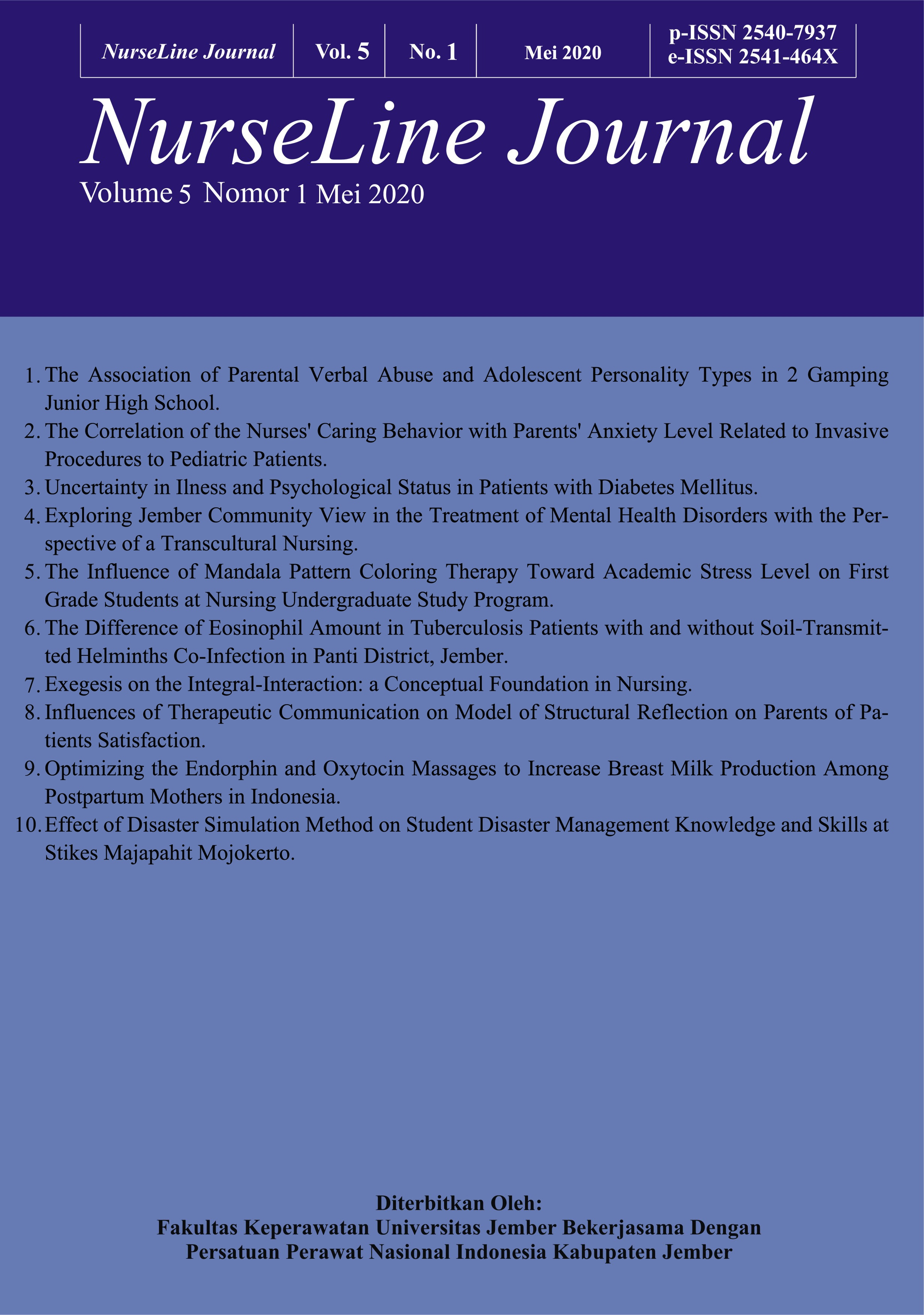Effect of Disaster Simulation Methods on Students Disaster Management Knowledge and Skills at STIKes Majapahit Mojokerto
DOI:
https://doi.org/10.19184/nlj.v5i1.17057Keywords:
disaster; student; simulation; knowledge; skillAbstract
Preparedness education for disasters is important because nurses must adapt to any conditions. But the phenomenon shows that not many nurses have the readiness and qualified experience in disaster relief efforts. The right step in improving the ability of nurses is to provide disaster education early on to nursing students. This study aims to determine the effect of disaster simulation methods on disaster management knowledge and skills in students at STIKes Majapahit Mojokerto. The design of this study was a pre-experiment with one group post-test only design. The sample of this research was all 7th-semester students of the Nursing Undergraduate Study Program at STIKes Majapahit Mojokerto with 21 respondents. The independent variable is the intervention of the disaster simulation method and the dependent variable is the knowledge and skills of disaster management. This study used a measuring tool in the form of a questionnaire sheet that was adopted and modified from the DPET (Disaster Preparedness Evaluation Tool) questionnaire. Analysis of the data in this study used the analysis of the mean. The study found that the mean value of disaster management knowledge and skills were at 4.50 (SD: 1.12) and 4.29 (SD: 1.04). The mean value is included in the moderate category. This disaster simulation method provides the opportunity and experience for students to be able to directly apply the theories obtained in class to situations that are made as closely as possible with disaster conditions. The results of this study are expected to be a reference in the development of more attractive and interesting learning methods on the topic of disaster management so that in the long run it can improve the ability of nurses in their roles when disasters occur.
Downloads
References
Baack, S., & Alfred, D. (2013). Nurses’ preparedness and perceived competence in managing disasters. Journal of Nursing Scholarship, 45(3), 281–287. https://doi.org/10.1111/jnu.12029
Chapman, K., & Arbon, P. (2008). Are nurses ready?. Disaster preparedness in the acute setting. Australasian Emergency Nursing Journal, 11(3), 135–144. https://doi.org/10.1016/j.aenj.2008.04.002
Chiang, H.-H., Ting, C.-W., Chao, E., & Chen, K.-J. (2020). Using tabletop exercises to evaluate nurses’ clinical performance of hazardous materials disaster management: A cross-sectional study. Nurse Education Today, 104358. https://doi.org/https://doi.org/10.1016/j.nedt.2020.104358
Dewi, R. N. (2015). Kesiapsiagaan Sumber Daya Manusia Kesehatan Dalam Penanggulangan Masalah Kesehatan Akibat Bencana Banjir Di Provinsi DKI Jakarta. Universitas Indonesia.
Fatmawati, A. (2018). Kajian Kompetensi Dosen Pendidikan Kesehatan : Perspektif Mahasiswa. Prosiding Seminar Nasional Hasil Penelitian Dan Pengabdian Masyarakat Seri Ke-2, 31–36. Mojokerto: Sekolah Tinggi Ilmu Kesehatan Majapahit.
Fung, O. W. M., Loke, A. Y., & Lai, C. K. Y. (2008). Disaster preparedness among Hong Kong nurses. Journal of Advanced Nursing, 62(6), 698–703. https://doi.org/10.1111/j.1365-2648.2008.04655.x
Greco, S., Lewis, E. J., Sanford, J., Sawin, E. M., & Ames, A. (2019). Ethical Reasoning Debriefing in Disaster Simulations. Journal of Professional Nursing, 35(2), 124–132. https://doi.org/https://doi.org/10.1016/j.profnurs.2018.09.004
Ireland, M., Ea, E., Kontzamanis, E., & Michel, C. (2006). Integrating Disaster Preparedness Into a Community Health Nursing Course: One School’s Experience. Disaster Management and Response, 4(3), 72–76. https://doi.org/10.1016/j.dmr.2006.03.001
Jose, M. M., & Dufrene, C. (2014). Educational competencies and technologies for disaster preparedness in undergraduate nursing education: An integrative review. Nurse Education Today, 34(4), 543–551. https://doi.org/10.1016/j.nedt.2013.07.021
Kamil, P. A., Utaya, S., Sumarmi, & Utomo, D. H. (2020). Improving disaster knowledge within high school students through geographic literacy. International Journal of Disaster Risk Reduction, 43, 101411. https://doi.org/https://doi.org/10.1016/j.ijdrr.2019.101411
Kaplan, B. G., Connor, A., Ferranti, E. P., Holmes, L., & Spencer, L. (2012). Use of an emergency preparedness disaster simulation with undergraduate nursing students. Public Health Nursing, 29(1), 44–51. https://doi.org/10.1111/j.1525-1446.2011.00960.x
Martono, M., Satino, S., Nursalam, N., Efendi, F., & Bushy, A. (2019). Indonesian nurses’ perception of disaster management preparedness. Chinese Journal of Traumatology - English Edition, 22(1), 41–46. https://doi.org/10.1016/j.cjtee.2018.09.002
Notoatmodjo, S. (2014). Ilmu Perilaku Kesehatan. Jakarta: Rineka Cipta.
Saharullah. (2015). Hubungan Pengetahuan, Sikap, Dan Tindakan Masyarakat Terhadap Kecamatan Tempe Kabupaten Wajo. Universitas Hasanuddin.
Sujarwo. (2015). Model pendidikan sadar lingkungan masyarakat korban erupsi Merapi berbasis potensi lokal. Cakrawala Pendidikan, 34(1), 12–23.
Tanwattana, P., & Toyoda, Y. (2018). Contributions of gaming simulation in building community-based disaster risk management applying Japanese case to flood-prone communities in Thailand upstream area. International Journal of Disaster Risk Reduction, 27, 199–213. https://doi.org/https://doi.org/10.1016/j.ijdrr.2017.10.007








